How To Make Cauliflower Pizza Crust: A Thorough Investigation
More than anything in life, I want to be able to eat pizza. However, as I reluctantly adhere to a gluten-free diet, the unlikelihood of this happening becomes grossly apparent.
I'm unsure of its origin, but the cauliflower crust pizza phenomenon has been plaguing the Internet with its oddness for a while now. From urban-gardening microbloggers to Food Network megastars, it seems everyone has a prescription for creating this grain-free crust alternative. When the food community starts making pizza promises — the most torturous kind of promises — I desperately want to believe them.
Admittedly, cauliflower is a miraculously versatile and delicious vegetable. The subtle, starchy sweetness of the root comes through nicely when roasted, and it develops a shockingly sumptuous texture when steamed and pureed. Prepared correctly, cauliflower makes a surprisingly adept substitute for a number of carbohydrate-laden foods: sandwich bread, rice, potatoes, pasta, and yes, pizza crust. Or so they say.
There are dozens of alternative flour mixtures that use a combination of xantham gum, arrowroot starch and other binding agents to mimic the stretchy, elastic properties of gluten. These flours tend to waver in their effectiveness but ultimately deliver a product safe for wheat-free diets. However, unlike cauliflower, these flours aren't necessarily healthier options when compared to basic all-purpose flour. The caloric content of King Arthur's gluten-free flour and Cup4Cup, arguably the best widely available gluten-free flours on the market, range from 120 to 146 calories per ¼ cup serving and 26 to 32 grams of carbohydrates. Standard Gold Medal all-purpose flour is 100 calories and 22 grams of carbohydrates per serving.
Cauliflower, by contrast, has only 7 grams of net carbohydrates per serving after you account for the stellar fiber content (up to 12 grams per head, raw) and natural sugars. As part of the cruciferous family of vegetables along with broccoli and cabbages, it is naturally gluten-free and boasts a 400 percent daily vitamin C content along with a host of other important bone-building minerals, like potassium and magnesium.
Cauliflower is clearly a healthier, nutrient-robust option compared to flour, gluten-free or otherwise — that all doesn't exactly need to be spelled out. But back to the point: Does it work as a pizza crust???
My goal was simple: I wanted a pizza crust structurally sound enough that it could be held like a regular slice. I would consider a "knife-and-fork pizza" to be a failure.
After preparing homemade tomato sauce and shredding fresh mozzarella, I pulled out my food processor and set to work. After researching competitive recipes, I opted to break down the florets into "rice" first (see directions below), then blanch in salted water instead of using a microwave. Not only is the microwave a wholly inconsequential appliance and the nemesis of fresh produce, the salted blanching water infuses more flavor into the crumbles and keeps the vegetable's integrity better. I drained and dried the results in a clean dish towel until no more water remained.
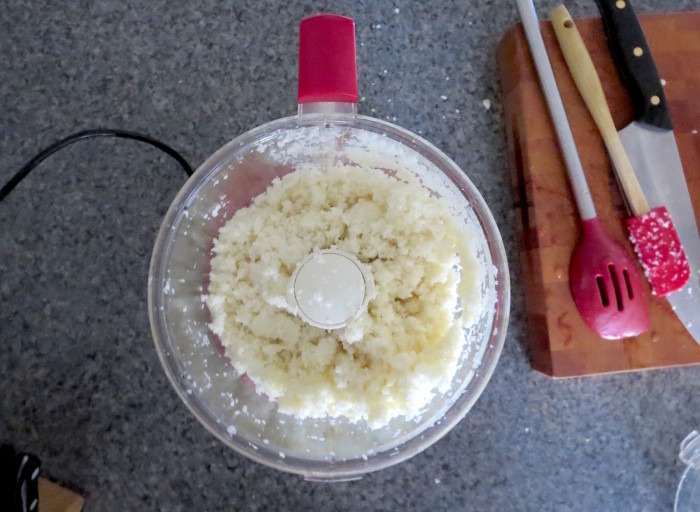
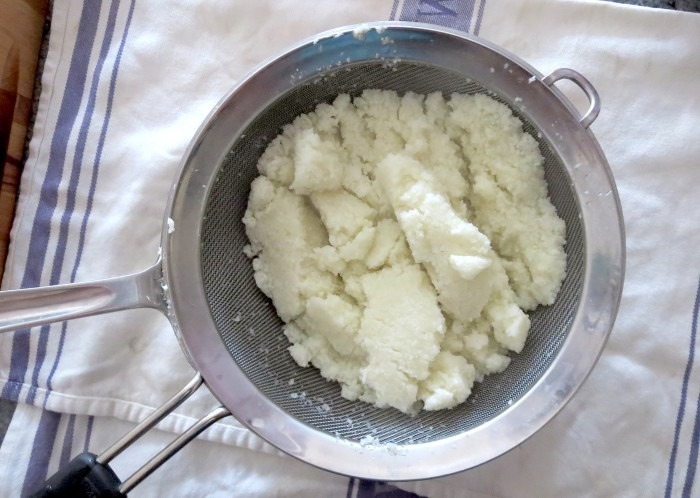
For the "dough," I incorporated a lightly beaten egg, aggressive seasoning with salt and pepper and a handful of shredded mozzarella. It was binding together, but felt too mushy. Improvising, I added a handful of gluten-free bread crumbs for texture. In theory, it would improve the damp tackiness of the faux dough and hopefully lend a desirable crunchiness to the bottom of the crust as it baked.
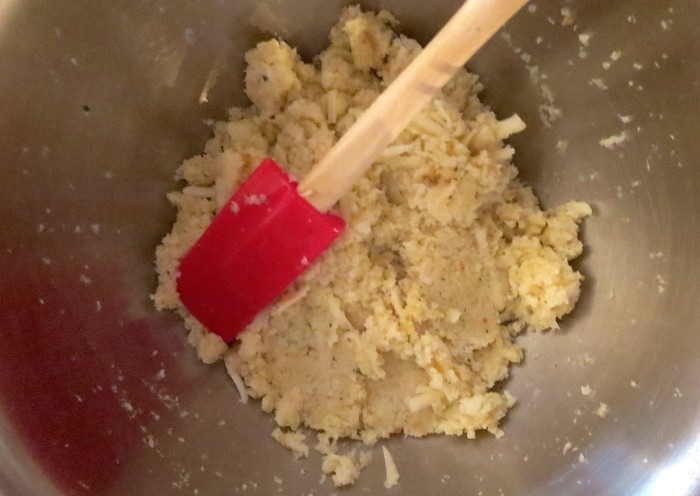
Channeling my inner Matisse, I sculpted a lovely round pizza crust. One smallish head of cauliflower equated to enough dough for a roughly 10-inch crust. I was hoping for a larger pizza, but had I pressed my crust a bit thinner to a scant ¼ inch, I might have been able to stretch it to a full 12-inch pie.
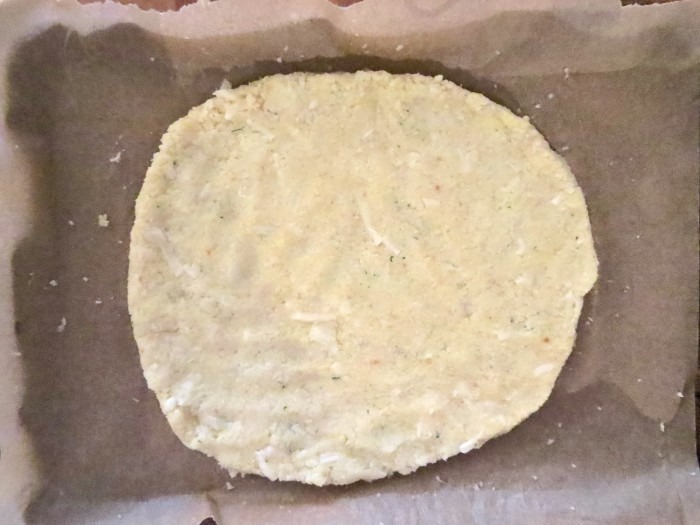
I baked the crust for 15 to 20 minutes until it started to brown, removed it to apply my sauce and toppings, and returned it to the oven to finish baking.
Once the cheese was bubbling and brown, I removed the pizza and let it cool. Secretly, I was worried the cauliflower needed to set further. I sliced into the pizza and realized my bread crumb trick only half worked. The bottom of the crust was not crispy like traditional dough — there was no crunch to it at all, in fact. Although the pizza lacked in texture, the slices held together nicely! I was able to remove a perfect quarter-pie without the slice collapsing.
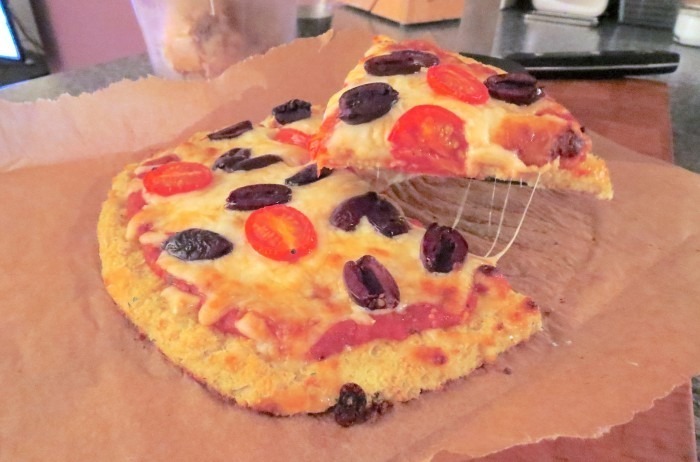
I recommend avoiding fatty or processed protein toppings, as the natural oils from pepperoni or sausage will weigh down on the crust, but try thinly sliced lean ham or prosciutto if you're really hankering. Use your best judgment — since there's no dough to absorb those oils and fats or hold up the weight of meat, you risk ending up with cauliflower mush.
The verdict? It was delicious! The flavors were super-fresh and not at all heavy. A sprinkling of salt and some briny toppings, like anchovies and olives, were necessary to lend some dimension and balance to the overall taste profile. The cauliflower crust developed a creamy, delicate flavor that complemented the sweet tomato sauce. It would pair well with a pesto or even a thin layer of béchamel. It's not exactly pizza, but it is a light, health-conscious dish that, when dressed properly, is full of flavor, and I'd make it again.
Cauliflower Pizza Crust
Ingredients
Directions

